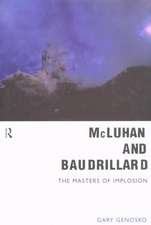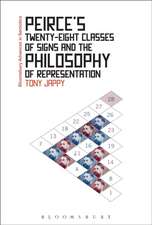Critical Semiotics: Theory, from Information to Affect: Bloomsbury Advances in Semiotics
Autor Gary Genoskoen Limba Engleză Paperback – 21 sep 2016
| Toate formatele și edițiile | Preț | Express |
|---|---|---|
| Paperback (1) | 231.16 lei 6-8 săpt. | |
| Bloomsbury Publishing – 21 sep 2016 | 231.16 lei 6-8 săpt. | |
| Hardback (1) | 831.43 lei 6-8 săpt. | |
| Bloomsbury Publishing – 21 sep 2016 | 831.43 lei 6-8 săpt. |
Din seria Bloomsbury Advances in Semiotics
- 14%
 Preț: 179.13 lei
Preț: 179.13 lei - 22%
 Preț: 271.40 lei
Preț: 271.40 lei - 22%
 Preț: 256.85 lei
Preț: 256.85 lei -
 Preț: 173.71 lei
Preț: 173.71 lei - 18%
 Preț: 238.84 lei
Preț: 238.84 lei - 30%
 Preț: 568.71 lei
Preț: 568.71 lei - 14%
 Preț: 171.77 lei
Preț: 171.77 lei - 14%
 Preț: 1006.79 lei
Preț: 1006.79 lei - 23%
 Preț: 190.96 lei
Preț: 190.96 lei - 23%
 Preț: 198.05 lei
Preț: 198.05 lei -
 Preț: 198.22 lei
Preț: 198.22 lei - 13%
 Preț: 232.07 lei
Preț: 232.07 lei - 13%
 Preț: 237.28 lei
Preț: 237.28 lei - 13%
 Preț: 258.42 lei
Preț: 258.42 lei - 24%
 Preț: 190.16 lei
Preț: 190.16 lei - 8%
 Preț: 299.19 lei
Preț: 299.19 lei - 23%
 Preț: 192.30 lei
Preț: 192.30 lei - 18%
 Preț: 306.47 lei
Preț: 306.47 lei - 22%
 Preț: 257.32 lei
Preț: 257.32 lei - 22%
 Preț: 223.58 lei
Preț: 223.58 lei - 30%
 Preț: 773.39 lei
Preț: 773.39 lei - 22%
 Preț: 226.79 lei
Preț: 226.79 lei - 22%
 Preț: 238.40 lei
Preț: 238.40 lei - 23%
 Preț: 192.73 lei
Preț: 192.73 lei - 22%
 Preț: 237.84 lei
Preț: 237.84 lei - 22%
 Preț: 1007.62 lei
Preț: 1007.62 lei - 8%
 Preț: 131.83 lei
Preț: 131.83 lei - 18%
 Preț: 305.53 lei
Preț: 305.53 lei
Preț: 231.16 lei
Preț vechi: 265.81 lei
-13% Nou
Puncte Express: 347
Preț estimativ în valută:
44.23€ • 46.31$ • 36.60£
44.23€ • 46.31$ • 36.60£
Carte tipărită la comandă
Livrare economică 07-21 aprilie
Preluare comenzi: 021 569.72.76
Specificații
ISBN-13: 9781472596369
ISBN-10: 1472596366
Pagini: 200
Dimensiuni: 156 x 234 x 22 mm
Greutate: 0.36 kg
Editura: Bloomsbury Publishing
Colecția Bloomsbury Academic
Seria Bloomsbury Advances in Semiotics
Locul publicării:London, United Kingdom
ISBN-10: 1472596366
Pagini: 200
Dimensiuni: 156 x 234 x 22 mm
Greutate: 0.36 kg
Editura: Bloomsbury Publishing
Colecția Bloomsbury Academic
Seria Bloomsbury Advances in Semiotics
Locul publicării:London, United Kingdom
Caracteristici
Responds to a contemporary critical challenge to semiotics by bringing in 'the affective turn'
Notă biografică
Gary Genosko is Professor of Communication and Digital Media Studies at the University of Ontario Institute of Technology in Toronto, Canada
Cuprins
Introduction1. From Information Theory to A-Signifying Semiotics2. Anti-Semiology3. Damaged Signs and Floating Signifiers4. Semiotics of the Info-commodity5. Obstacle-Signs6. Tensor Signs7. Affect and SemiosisConclusionReferencesIndex
Recenzii
This important contribution to the history of critical theory establishes crucial connections among information theory, semiotics, Marxist critique, and affect theory. By confronting obstacles to signification such as libidinal economies and commodification, Genosko provides a much-needed rereading of theories of signification, demonstrating that semiotics still matters in the age of big data, global consumerism, and visual media.
Just like Zizek in his critique of the Warchowski's Matrix, Genosko in his Critical Semiotics rejects the false choice between the material blue pill and the semiotic red pill. However, he does not opt for a third pill, especially not the dialectical purple one. Following Guattari and a number of his sometimes delightfully unlikely bedfellows, Genosko reiterates the call for semiotic disobedience. Most crucially, the plea is not predicated on the facile rejection of the discursive in favour of the pathic. Rather, Genosko's intricate mapping of the interface between expression and content remains necessarily contingent. Hence semiosis as a critique, a must-read for those living under the regime of semiocapitalism.
In his characteristic rigour, precision and scholarly attention to texts, Genosko offers up a wide ranging and compelling history and theory of semiotics as both critical and creative practice. With tour de force readings of key post-structualist thinkers and its own original insights and contemporary case studies, this book effectively re-writes sign and affect theory. A must for all those working at the leading edge of the theoretical humanities.
Just like Zizek in his critique of the Warchowski's Matrix, Genosko in his Critical Semiotics rejects the false choice between the material blue pill and the semiotic red pill. However, he does not opt for a third pill, especially not the dialectical purple one. Following Guattari and a number of his sometimes delightfully unlikely bedfellows, Genosko reiterates the call for semiotic disobedience. Most crucially, the plea is not predicated on the facile rejection of the discursive in favour of the pathic. Rather, Genosko's intricate mapping of the interface between expression and content remains necessarily contingent. Hence semiosis as a critique, a must-read for those living under the regime of semiocapitalism.
In his characteristic rigour, precision and scholarly attention to texts, Genosko offers up a wide ranging and compelling history and theory of semiotics as both critical and creative practice. With tour de force readings of key post-structualist thinkers and its own original insights and contemporary case studies, this book effectively re-writes sign and affect theory. A must for all those working at the leading edge of the theoretical humanities.














